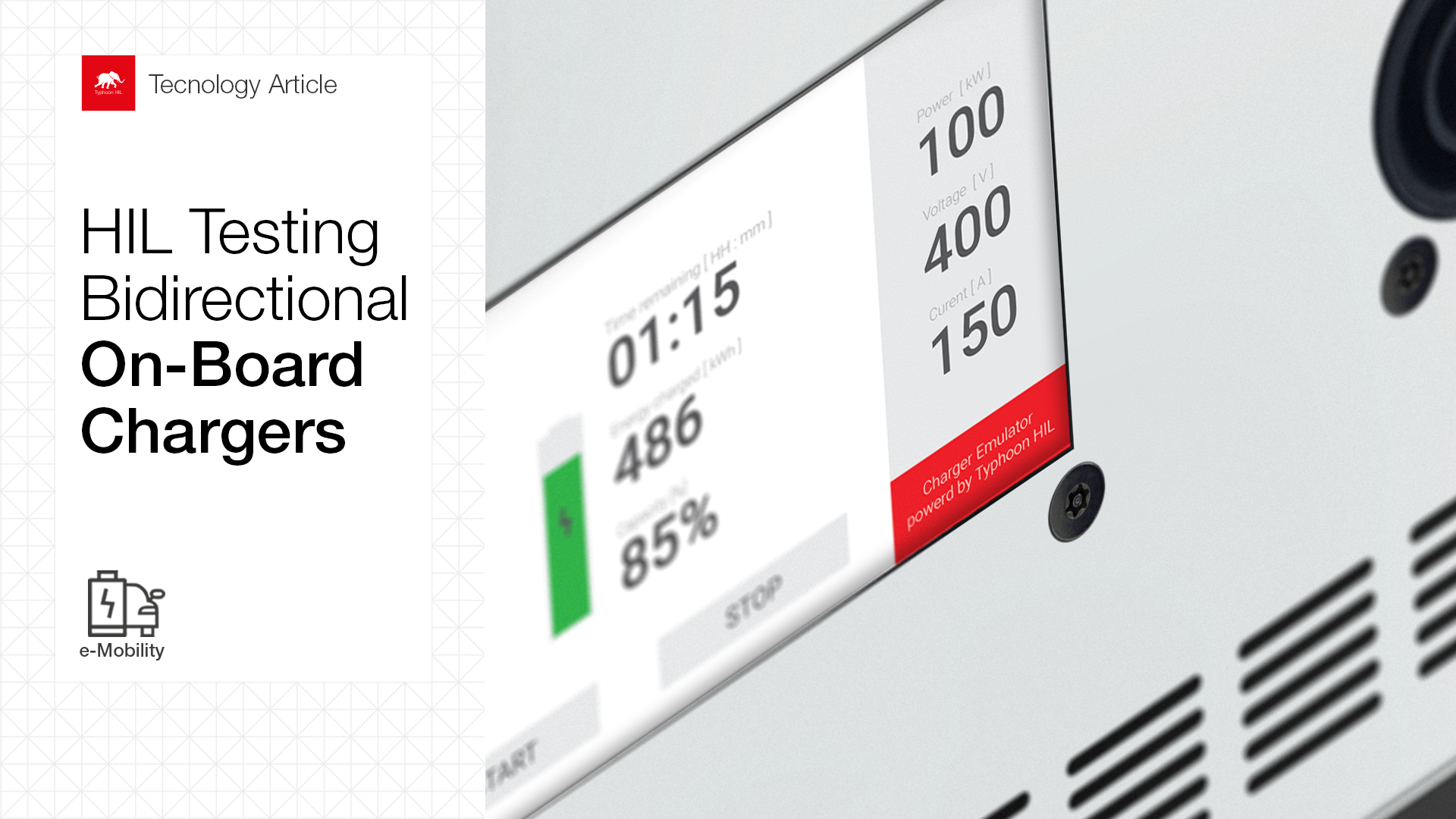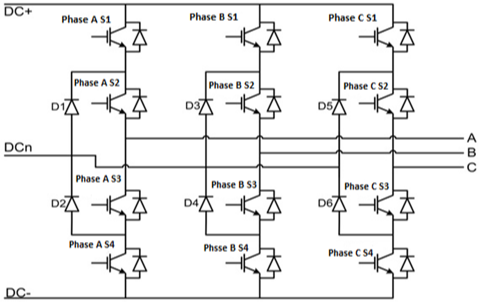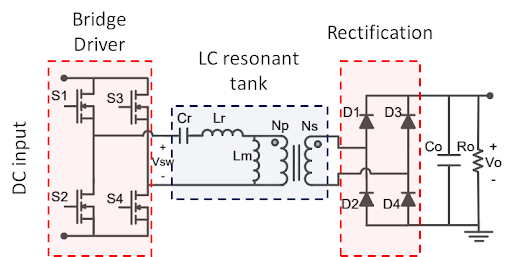
Bidirectional onboard chargers (OBCs) are a key driving force behind the growth of Vehicle-to-Grid (V2G) applications, playing a pivotal role in balancing energy supply and demand. This blog explores the critical aspects of bidirectional OBCs and highlights the significance of HIL testing in ensuring their seamless integration and optimal performance.
Introduction | Bidirectional On-Board Chargers and V2G
Bidirectional charging is the essence of V2G technology, enabling electric vehicles (EVs) to consume grid energy and operate as a power source when required. EVs can power off-grid loads or return energy to the grid when working as a power source. Bidirectional On-Board Chargers (OBCs) are the crucial link that makes this dynamic energy exchange possible. These chargers are equipped with advanced power electronics and control algorithms that enable the efficient flow of energy in both directions. By facilitating bidirectional power exchange, OBCs empower EVs to participate in grid stabilization and support renewable energy expansion.
The transformative potential of bidirectional charging extends beyond energy flexibility. The integration of EVs into the grid brings numerous advantages, with peak shaving being particularly noteworthy. Through strategic energy supply during high-demand periods and subsequent replenishment during low-demand periods, bidirectional charging can reduce grid stress. Load leveling emerges as another advantage, as bidirectional OBCs distribute grid energy fluctuations across a diverse fleet of EVs, thereby mitigating localized load imbalances and enhancing grid resilience.
Several power converter topologies can indeed be used for bidirectional On-Board Chargers (OBCs). Typically, an OBC consists of two primary components: an AC-DC converter and a DC-DC stage. The AC-DC converter is responsible for converting alternating current (AC) from an external power source (e.g., a charging station or grid) into direct current (DC) for charging the vehicle's battery. The DC-DC stage, on the other hand, serves two essential purposes. Firstly, it provides galvanic isolation, which is critical for safety standards and helps prevent electric shock hazards. Secondly, it can step up or step down the DC voltage to match the requirements of the high-voltage (HV) battery, such as reaching 1000V, ensuring efficient energy transfer and storage. Totem-pole PFC converters, for example, are known for their high efficiency, which is crucial for bidirectional chargers as they need to efficiently convert energy in both directions—charging the vehicle's battery and returning energy to the grid when the vehicle is acting as a power source (see Fig. 1). They can also be more compact compared to other topologies, since they only use 4 power electronic switches, which is beneficial for onboard applications where space is limited.

Figure 1. Totem-pole PFC topology. [Source]
In the three-level NPC/ANPC topology (see Fig. 2), switches only block half the bus voltage, allowing for lower-rated MOSFETs and reduced voltage stress on devices. This works well with SiC, GaN, and silicon switches, adapting to varied applications. Moreover, on the NPC setup, output current ripple drops and output-voltage transients decrease by 50%, cutting the need for extensive filtering and enabling smaller filter inductors. This boosts power density with less inductance to manage current waveform distortion. This topology also maintains low output voltage disturbance, minimizing device stress and improving EMI performance.

Figure 2. A schematic block diagram of a three-phase three-level NPC inverter/rectifier block diagram with corresponding switch naming. [Source]
In the DC-DC stage the Dual-Active Bridge (DAB) and resonant converter topologies stand out as compelling choices for OBCs. The DAB converter boasts high power handling capabilities, making it ideal for fast-charging EVs. Its precise control and bidirectional power flow ensure efficient energy transfer, making it an excellent option for high-power applications. On the other hand, resonant converters, such as the LLC (L-L-C) resonant converter (see Fig. 3), are renowned for their high efficiency and reduced electromagnetic interference (EMI). These converters operate at resonant frequencies, minimizing switching losses and heat generation. This translates to improved efficiency and reliability in OBCs, especially in scenarios where minimizing EMI is crucial. Both DAB and resonant converters contribute significantly to the efficiency and performance of OBCs, catering to different application needs and demanding stringent specifications.

Figure 3. General LLC resonant converter topology. [Source]
Challenges | Control and Communication Complexity
Seamless integration of bidirectional OBCs with diverse vehicle systems is a significant challenge in the e-Mobility industry. These chargers must communicate flawlessly with the battery management system (BMS), electronic control unit (ECU), and charging infrastructure. This requires thorough integration testing to ensure accurate data exchange, precise command execution, and robust fault-handling mechanisms. Moreover, bidirectional operation requires sophisticated control algorithms, such as reactive power compensation, harmonic mitigation, load tracking, power sharing, and anti-islanding, which can add complexity to the control system.
The importance of fault tolerance and error handling cannot be understated. Bidirectional OBC controllers must be equipped to handle various communication errors and recover from faults seamlessly. Developing comprehensive test scenarios that replicate different communication anomalies and assessing the charger’s responses has been challenging automotive engineers.
Another roadblock is complying with communication standards. ISO 15118, for example, defines a comprehensive set of technical requirements for EV communication, including data exchange formats, encryption, digital signatures, and authentication mechanisms. Implementing these technical specifications correctly can be challenging, particularly for manufacturers and developers who may not have previous experience with such protocols. Before deploying EVs and charging stations, rigorous testing and certification processes are necessary to ensure compliance with ISO 15118. This may involve third-party testing laboratories and certification authorities, which adds to the complexity and cost of compliance.
HIL Benefits | Accelerate Bidirectional OBC Testing with HIL
Harnessing the power of Hardware-in-the-Loop (HIL) testing is crucial in overcoming these challenges and elevating bidirectional OBC testing to a higher level. HIL testing enables early-stage validation of control algorithms and communication protocols, preemptively addressing design flaws and ensuring the charger's bidirectional functionality is precisely tuned.
By simulating real-world conditions, HIL testing significantly reduces reliance on physical hardware components, expediting testing cycles and optimizing resource allocation. In addition, it facilitates the creation and replication of numerous scenarios (including risk-free fault testing), allowing comprehensive assessment of the charger's behavior.
HIL testing also simplifies the process of compliance testing with safety and communication standards, such as ISO 15118, ensuring that bidirectional OBCs comply with industry-defined benchmarks.
Typhoon HIL testing offers controlled simulation for you to validate bidirectional OBCs, ensuring realistic scenarios through ultra-high fidelity models, efficient control algorithm testing through automated testing, and early issue detection. It minimizes risks, speeds up development, and guarantees reliable and optimized OBC systems.
To learn more about our offering, you can watch our video tutorials on the ISO 15118 Plug and Charge and XCP over CAN protocol implementations, the latest ISO 15118 Charging Protocol Updates, and the implementation of the 25 ns DC-DC solver.
Are you exploring adopting HIL in your work?
Contact us to schedule a free demo.
Are you interested to learn more?
Watch our 25 ns DC-DC solver video tutorial.
Are you interested in more stories like this?
Check out our other blogs.
Credits:
Text | Cassiano F. Moraes and Heitor J. Tessaro
Visuals | Milica Obradovic
Editor | Debora Santo, Juliano Grigulo



